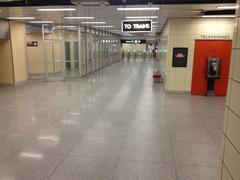
Jane Toronto Canada Visiting Hours, Tickets, and Historical Sites Guide
Date: 15/06/2025
Introduction: Jane Area in Toronto – History and Significance
Located in northwest Toronto, the Jane area—most notably the Jane and Finch neighbourhood—is a vibrant community shaped by decades of urban development, multicultural growth, and community resilience. Once farmland, the area transformed in the 1960s–70s to meet the city’s burgeoning need for affordable housing, evolving into one of Toronto’s most ethnically diverse neighbourhoods. It now reflects a multicultural tapestry of Black, Caribbean, South Asian, Filipino, and Latin American communities, and stands as a microcosm of Toronto’s broader history and diversity (Wikipedia: Jane and Finch).
The Jane area is home to significant cultural landmarks such as Black Creek Pioneer Village, a living history museum that brings 19th-century Ontario to life (Black Creek Pioneer Village), and the Jane Finch Community Centre, which serves as a hub for multicultural events, social programs, and community empowerment (City of Toronto Jane-Finch Community Centre). Ongoing transit improvements—like the Finch West subway and the planned LRT—continue to enhance accessibility and support the neighbourhood’s ongoing transformation (Toronto.ca RapidTO Jane Street).
This comprehensive guide explores the Jane area’s historical roots, cultural sites, transit options, recreational spaces, safety considerations, and practical visitor information—helping you experience this unique Toronto neighbourhood in depth.
Table of Contents
- Introduction
- Historical Development
- Demographics & Cultural Significance
- Urban Renewal & Transit Development
- Recreation, Green Spaces, & Events
- Safety, Reputation, & Community Resilience
- Visitor Information: Hours, Tickets, Accessibility
- FAQs
- Visuals & Media Recommendations
- Related Links & Resources
- Conclusion & Call to Action
Historical Development of the Jane Area
Early History & Urban Planning
Originally rural farmland in the historic Elia community, the Jane area’s transformation began in the 1960s. Development was spearheaded by the Ontario Housing Corporation and North York Planning Department, addressing Toronto’s urgent need for affordable, high-density housing (Wikipedia: Jane and Finch). The area’s population exploded from around 1,300 in 1961 to over 33,000 by 1971, accounting for more than 40% of North York’s growth during that decade.
The urban plan mixed public and private housing—single-family homes, semi-detached houses, and high-rise apartments—creating a densely populated, diverse neighbourhood.
Social Infrastructure & Community Challenges
While housing development was rapid, social infrastructure initially lagged, leading to economic difficulties and limited access to community services (Wikipedia: Jane and Finch). These challenges contributed to a reputation for higher crime, but ongoing community initiatives have fostered resilience and revitalization.
Demographic Evolution & Cultural Significance
The Jane area is one of Toronto’s most ethnically diverse neighbourhoods, with more than 50% of residents born outside Canada. The 2021 census recorded over 21,000 people in northern Black Creek and 30,000 in southern Glenfield-Jane Heights. The neighbourhood’s rich cultural mix is reflected in local businesses, festivals, and community programs (Wikipedia: Jane and Finch).
Heritage & Cultural Sites
Black Creek Pioneer Village is a standout attraction—an open-air museum with 40+ heritage buildings and costumed interpreters, depicting 19th-century Ontario life. Visiting hours are generally 10 AM–5 PM (spring/summer), with reduced hours in fall and special events in winter. Check the Black Creek Pioneer Village website for current details.
Schools, community centres, and libraries further enrich the area’s cultural landscape, supporting education and cross-cultural engagement.
Urban Renewal & Transit Development
The Jane area has seen major transit investment in recent years. The 2017 subway extension brought Finch West station close to the Jane and Finch intersection, greatly improving access (Wikipedia: Jane and Finch). The upcoming Finch West LRT and RapidTO bus priority lanes promise even more connectivity and transit efficiency (Toronto.ca RapidTO Jane Street).
Community consultation has focused on balancing transit upgrades with the needs of local businesses, pedestrians, and residents (RapidTO: Jane Street Consultation Report).
Recreation, Green Spaces, & Events
Despite its urban density, the Jane area features green spaces like Fennimore Park, Driftwood Park, and Oakdale Park, as well as the Black Creek ravine. Community centres, including Driftwood and Domenico DiLuca, offer year-round programming.
Oakdale Golf & Country Club has hosted the Canadian Open and will do so again in 2026 (Wikipedia: Jane and Finch). Check local event calendars for multicultural festivals and markets that celebrate the neighbourhood’s unique heritage.
Safety, Reputation, & Community Resilience
Jane and Finch has long been associated with higher crime rates and social challenges (History of Toronto: Top 5 Neighborhoods to Avoid). However, the area’s deep-rooted activism and arts scene, as well as initiatives like the “University Heights” rebranding, highlight positive changes and a strong sense of community (Wikipedia: Jane and Finch).
Visitor Information: Hours, Tickets, and Accessibility
- Black Creek Pioneer Village: Open Tuesday–Sunday, 10 AM–5 PM (spring/summer), 10 AM–4 PM (fall); closed in winter except for select events. Check official site for seasonal hours and ticket prices.
- Jane Finch Community Centre: Open Monday–Saturday, 8 AM–9 PM; admission is free for most events (City of Toronto Jane-Finch Community Centre).
- Transit: Served by TTC buses and the Finch West subway, with enhanced service coming via the Finch West LRT. Use TTC trip planner for real-time info.
- Accessibility: Most buses and community facilities are wheelchair-accessible; sidewalks and older stops may vary in accessibility.
- Safety: Use standard urban precautions, especially after dark, and stay in well-lit, populated areas.
FAQs
Q: What are the visiting hours for Black Creek Pioneer Village?
A: Typically 10 AM–5 PM (spring/summer), with reduced hours in fall. Closed in winter except for special events. Check the official website for current details.
Q: Is there an admission fee for Black Creek Pioneer Village?
A: Yes, tickets are required. Prices vary by age; family and group rates available.
Q: How do I get to the Jane area by public transit?
A: TTC buses connect to Finch West subway station; upcoming LRT will provide additional service.
Q: Is the Jane area family-friendly?
A: Yes—parks, community centres, and cultural events welcome families and visitors of all ages.
Visuals & Media Recommendations
- Use high-quality images of Black Creek Pioneer Village, Driftwood Park, and community events.
- Alt tags should include phrases like “Jane and Finch cultural sites” and “Toronto Jane area transit.”
- Consider embedding interactive maps or virtual tours of historical sites.
Related Links & Resources
- Black Creek Pioneer Village Official Site
- City of Toronto Visitor Information
- Toronto Transit Commission (TTC)
- RapidTO Jane Street Project
- Toronto Public Library - York Woods Branch
Conclusion & Call to Action
The Jane area exemplifies Toronto’s dynamic heritage and multicultural vitality, offering an array of cultural sites, green spaces, and community experiences. From Black Creek Pioneer Village to the Jane Finch Community Centre, there’s much to explore. Plan your visit by checking official resources, participating in local events, and using the Audiala app for guided tours and updates. Discover the unique spirit of Jane in Toronto and become part of its ongoing story.
In-Depth: Visiting Black Creek Pioneer Village
Overview
Black Creek Pioneer Village is Toronto’s premier living history museum, with 40+ heritage buildings and immersive experiences that transport visitors to 19th-century Ontario (Black Creek Pioneer Village).
Hours & Admission
- Spring/Summer: Tuesday–Sunday, 10:00 AM–5:00 PM
- Fall: Tuesday–Sunday, 10:00 AM–4:00 PM
- Winter: Closed except for special holiday events
- Admission: Adults $15, Seniors $12, Youth $10, Children $8, Under 5 free. Family and group rates available.
Experiences
- Guided tours and costumed interpreters
- Hands-on workshops and festivals (e.g., Pioneer Christmas, Harvest Festival)
- Check event calendar for special programming
Amenities
- Wheelchair-accessible paths and washrooms
- Parking, picnic areas, café, and gift shop
Nearby Attractions
Public Transit and Safety on Jane Street
Jane Street is a major north-south artery in Toronto, served by high-frequency TTC buses (35 Jane, 935 Jane Express), two subway stations (Jane and Pioneer Village), and priority bus lanes under the RapidTO initiative (Toronto.ca RapidTO Jane Street).
For fare information, current schedules, and real-time alerts, consult the TTC.
Safety Tips:
- Toronto remains a safe city, but use standard urban precautions—especially in the Jane & Finch area after dark (Nomadic Matt), (Chasing Chanelle).
- Use official transit fare vendors and avoid displaying valuables.
Accessibility:
Most TTC buses and stations are wheelchair-accessible; Wheel-Trans provides additional service for eligible riders.
Exploring the Jane Finch Community Centre
Historical and Cultural Importance
The Jane Finch Community Centre is a vital hub reflecting the area’s diversity and resilience, offering programs for youth, seniors, and newcomers (Inner City Outreach). Events and festivals celebrate 80+ ethno-cultural backgrounds.
Visiting Information
- Hours: Monday–Saturday, 8:00 AM–9:00 PM (City of Toronto Jane-Finch Community Centre)
- Admission: Free for most programs; some special events may require registration or a nominal fee.
- Transit: Accessible via TTC bus routes along Jane Street and Finch Avenue, and near Finch West and Jane subway stations.
Nearby Amenities
Discover global cuisine (Caribbean, African, Asian, Middle Eastern) and authentic bakeries along Jane and Finch avenues. Parks and community gardens offer green respite.
Accessibility:
The centre is wheelchair-accessible; TTC buses serving the area are also equipped for accessibility.
Safety:
Exercise normal urban awareness, particularly after dark. Daytime visits are generally safe and welcoming.
Summary & Recommendations
The Jane area is a testament to Toronto’s cultural richness, resilience, and urban evolution. From the immersive Black Creek Pioneer Village to the lively Jane Finch Community Centre and expanding transit infrastructure, visitors can experience a thriving, diverse community (Wikipedia: Jane and Finch; Black Creek Pioneer Village; City of Toronto Jane-Finch Community Centre).
Plan visits around events, use public transit, and enjoy the neighbourhood’s authentic spirit. For guided experiences and up-to-date news, download the Audiala app.
References
- Wikipedia: Jane and Finch
- Black Creek Pioneer Village Official Site
- Toronto.ca RapidTO Jane Street Project
- City of Toronto Jane-Finch Community Centre page
- Wikipedia: Jane Street (Toronto)
- Inner City Outreach
- RapidTO: Jane Street Consultation Report
- History of Toronto: Top 5 Neighborhoods to Avoid
- TTC
- Nomadic Matt
- Chasing Chanelle
- Ontario Away




























































































































































































